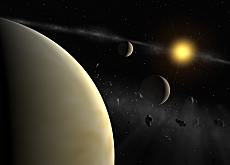Researcher finds lava, not water, flowed on Mars

Instead of water, flows of lava may have formed the massive canyons and gorges visible on the Mars’ surface, a geoscientist from the ETH Zurich has found, concluding that life on the red planet is less likely than previously thought.
Researchers had so far believed that a network of deep gorges known as the Noctis Labyrinthus and Mars’s largest canyon, the 4,000-kilometre-long Valles Marineris, were shaped by massive flows of water.
Most studies over the past 20 years have been concerned with the question of water on Mars and how it could have carved the canyons, allowing for speculation that there may be some form of life on the planet closest to Earth.
However, Italian volcanologist Giovanni Leone at the Federal Institute of Technology ETH Zurich is challenging that theory, finding that there would never have been enough water on Mars to carve the gigantic valleys into the planet’s landscape and that the large canyons could only have been formed by lava.
“If we suppose that lava formed the Noctis Labyrinthus and the Valles Marineris, then there has always been much less water on Mars than the research community has believed to date,” Leone told swissinfo.ch.
A new direction
The shallow ocean north of the Martian equator was probably much smaller than previously thought, meaning the likelihood of life on Mars is accordingly much lower, Leone added. This conclusion may have far-reaching consequences as it challenges decades of previous research.
After finding out that one canyon was located on the flanks of a large volcano on the red planet, Leone examined thousands of high-resolution surface images taken by numerous Mars probes, including the latest from the Mars Reconnaissance Orbiter. Those images are available on the US Geological Survey’s image databases.
“Everything I observed on those images were structures of lava flows as we know them on Earth. The typical indicators of erosion by water were not visible on any of them,” Leone said.
Leone does not completely rule out water as a final formative force for the canyons, however. Evidence of water – such as salt deposits in locations where water evaporated from the ground or signs of erosion – is rare, but does exist, he concedes.
“But it is impossible that there ever was enough water to have formed the gorges.”
Theory’s origins
Theories of Martian gorges shaped by water date back to an Italian astronomer in the 19th century who, for the first time, described them as ‘canali’, or canals.
Although another researcher suggested lava as cause of the gorges’ formation in 1977, the idea failed to gain traction and researchers continued to follow the common theory that they had been shaped by water. This was in part because pictures from the planet’s surface previously had a much lower resolution, Leone explained.
Life in lava tubes?
In his research, Leone argues a river strong and large enough to shape the gorges could not exist because the water on the surface of the cold planet would never have stayed liquid but would have frozen.
Leone’s new model illustrates the history of how the gorges formed, from the source to the outlet of the deep valleys. He says that so-called “lava tubes,” or underground air pockets formed after a volcanic eruption, are the only place where life could possibly survive on Mars.
“These lava tubes still in existence are possible habitats for living organisms, as they would offer protection from the powerful UV rays that pummel the Martian surface.”
Leone therefore proposes a Mars mission to explore that underground network of lava tubes. He believes it’s feasible to send a rover through a hole in the ceiling of a tube and search for evidence of life, since it is also known where the entrance to the tunnels is located.
His study was recently published in the Journal of Volcanology and Geothermal Research.

In compliance with the JTI standards
More: SWI swissinfo.ch certified by the Journalism Trust Initiative


You can find an overview of ongoing debates with our journalists here. Please join us!
If you want to start a conversation about a topic raised in this article or want to report factual errors, email us at english@swissinfo.ch.